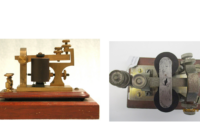
Unveiling the Sound Telegraph: Transforming Communication Through Sound
Introduction:
In the evolution of telegraphic communication, the Sound Telegraph emerged as a groundbreaking innovation during the 19th century. This technology harnessed sound-based signaling to transmit messages, marking a pivotal advancement in long-distance communication.
The Sound Telegraph stands as a pivotal innovation in the history of telegraphic communication during the 19th century. Utilizing audible signals to transmit messages, this technology marked a significant leap forward in long-distance communication methods.
Historical Context:
The development of the Sound Telegraph arose from continuous efforts to improve telegraphic systems following earlier technologies like the Morse Telegraph and the Dial Telegraph. Inventors and scientists sought innovative methods to enhance the efficiency and reach of communication networks.
Development and Operational Mechanisms:
The Sound Telegraph operated on the principle of sound-based signaling, utilizing mechanisms such as bells or sounders to convey messages. It employed distinctive sound patterns or sequences to represent letters, numbers, or characters, enabling operators to interpret and decode messages.
The Sound Telegraph relied on sound-based signaling devices, employing bells, sounders, or other audible mechanisms to transmit messages. Distinct sound patterns or sequences were used to represent characters, often following Morse code or other predetermined codes, enabling operators to interpret and decode the messages.
Key Components and Functionality:
- Sound Signaling Devices: Utilized bells, sounders, or other audible devices to produce distinct sound patterns.
- Encoding System: Employed specific sequences of sound to represent characters, often using Morse code or other predetermined codes.
- Operator Interface: Operators interacted with the telegraph system to generate and interpret the sound-based signals, facilitating the transmission and decoding of messages.
Advantages and Impact:
The Sound Telegraph brought significant improvements in audible message transmission. Its reliance on sound-based signaling allowed for clearer and audible messages, enhancing the speed and accuracy of communication. This innovation had a profound impact across various industries, facilitating faster and more efficient information exchange, particularly in scenarios where audible signals were advantageous.
Notable Inventors and Contributions:
Inventors such as Elisha Gray and Alexander Graham Bell made noteworthy contributions to the development and refinement of the Sound Telegraph. Their innovative designs and contributions in sound-based communication technologies played a vital role in shaping the functionality and effectiveness of this revolutionary system.
Legacy and Transition:
The Sound Telegraph marked a crucial juncture in the history of telegraphic communication, improving the audibility and efficiency of transmitted messages. Although later technologies eventually surpassed its capabilities, the Sound Telegraph’s legacy endured as a significant advancement in the evolution of telecommunications, emphasizing the exploration of audible communication methods.
Conclusion:
The Sound Telegraph remains a testament to human ingenuity in communication technology. Its reliance on sound-based signaling enhanced message clarity and audibility, contributing to the efficiency and effectiveness of global communication networks. Despite being surpassed by subsequent advancements, the Sound Telegraph’s legacy endures as a milestone in the evolution of telecommunications, showcasing the innovative exploration of audible communication methods.
Understanding the significance of the Sound Telegraph provides insight into the ongoing pursuit of diverse communication methods and the iterative nature of technological progress that continues to shape our interconnected world today.
